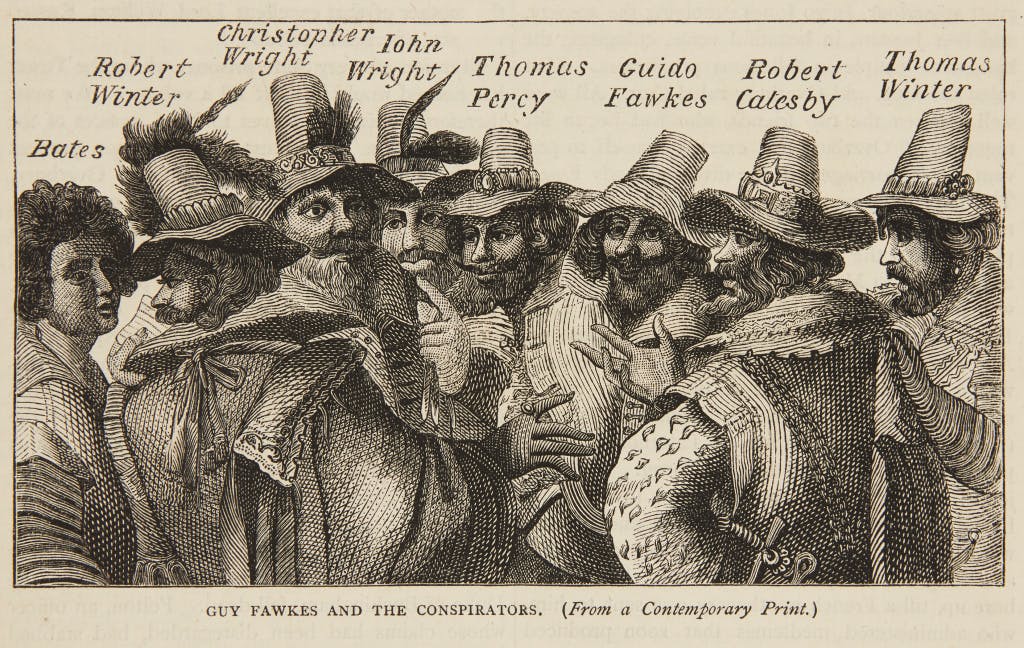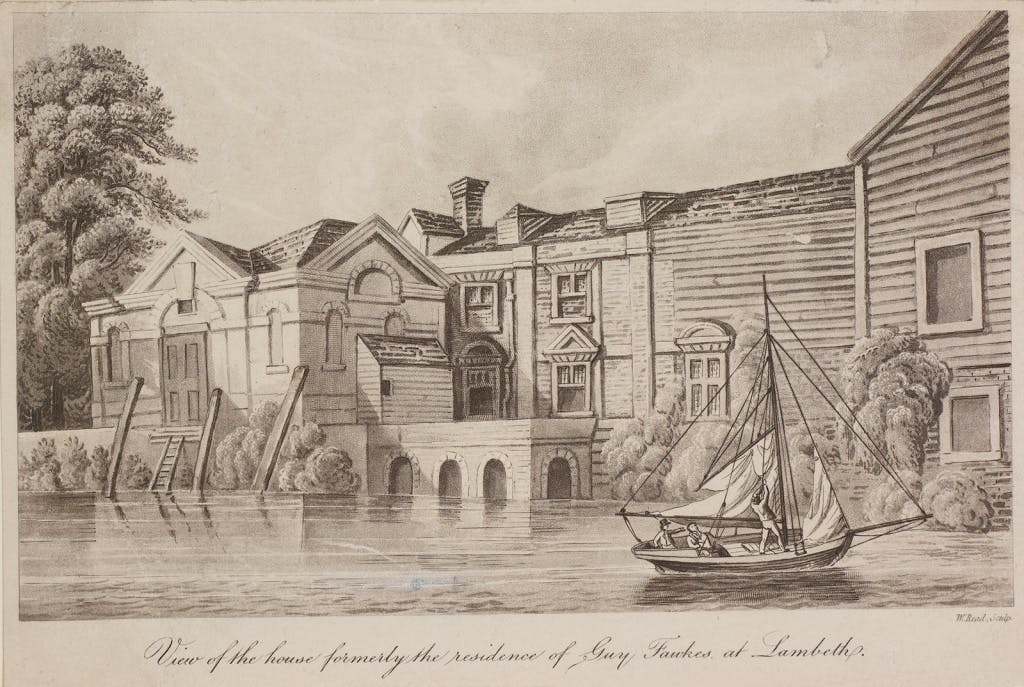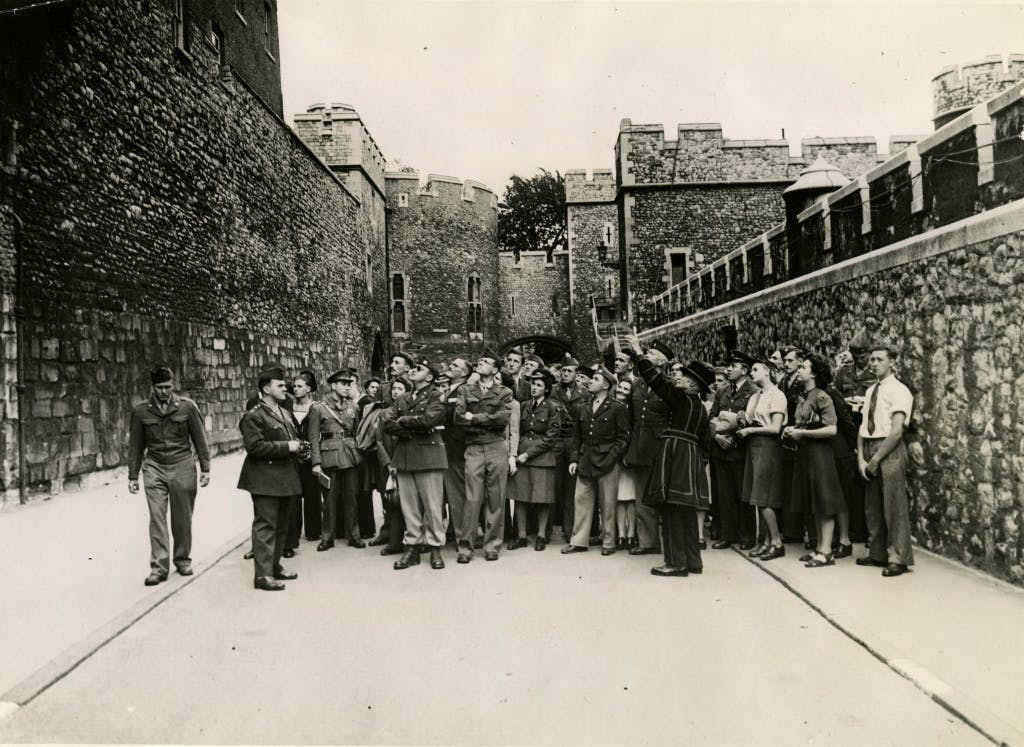
Who was the man behind the mask?
Every 5 November in Britain on Guy Fawkes Day, we remember the Gunpowder Plot of 1605, when Guy Fawkes and fellow Catholic conspirators attempted to blow up Parliament and assassinate James I and VI of England.
Everyone knows how Fawkes was caught in the act, imprisoned and tortured at the Tower of London and that he and most of his fellow conspirators suffered a traitor’s hideous death in Westminster. But who was the real Guy Fawkes, the man behind the mask?
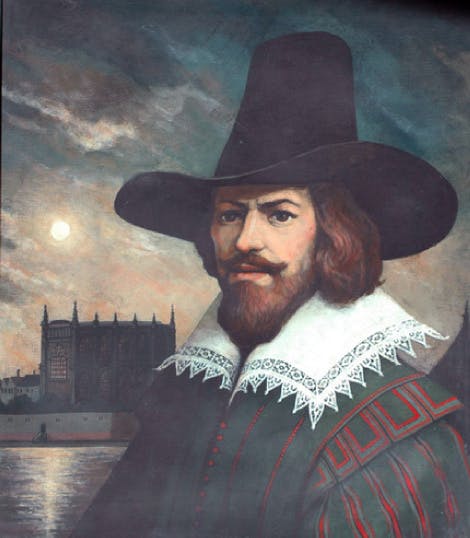
Image: Portrait of Guy Fawkes © St Peter's Foundation
Who was the real Guy Fawkes?
When was Guy Fawkes born?
Guy Fawkes was born in York in 1570. He was the son of Edward, a church lawyer and prominent Protestant in the city, and Edith, whose family included secret Catholics. He had two brothers, John and Christopher.
At that time, it was dangerous to be Catholic: many plots and rebellions against Elizabeth I were led by Catholics, which led to severe reprisals. Priests who were caught leading secret services were tortured and executed.
Why did Guy Fawkes convert to Catholicism?
To all outward appearances, Guy Fawkes' family were a law-abiding Protestant family, until his father Edward died when he was 8 years old. His mother remarried, this time to a Catholic, Dionysius Bainbridge.
The young Guy was drawn strongly to his stepfather’s religion, and although he knew of the dangers, he converted to Catholicism.
At the age of 21, the passionate young man set off to Europe to fight for Catholic Spain against Protestant Dutch reformers in the Eight Years War.
A handsome Guy
Fawkes had grown into a good looking man, tall and strong, with thick reddish-brown hair and beard, and an impressive moustache. His compatriots in Europe described him admiringly as:
‘A man of great piety, of exemplary temperance, of mild and chearful demeanour, an enemy of broils and disputes, a faithful friend, and remarkable for his punctual attendance upon religious observance.’
Guy Fawkes’s future took a fateful turn when he met Englishman Thomas Wintour in Spain. Wintour was scouting around for allies to join a group of Catholic conspirators based in England, led by his cousin Robert Catesby. Devout Fawkes was a perfect match, brave and skilful. The two men returned to England in 1604, where James I and VI had acceded to the throne the previous year.
Did you know?
It was in Spain that Guy also became known as ‘Guido’ Fawkes.
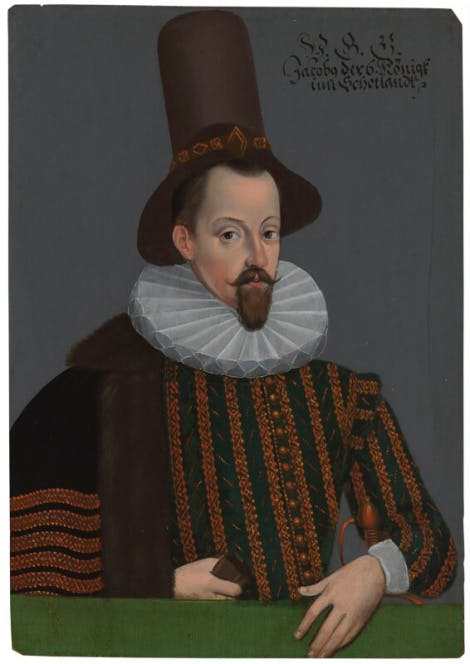
Image: King James I of England and VI of Scotland, © National Portrait Gallery, London
Why did Guy Fawkes try to blow up Parliament?
With the new reign, Catholics across the country had hoped for the end of the religious persecution they suffered for so long.
After all, the King's mother - Mary, Queen of Scots - had been a devout Catholic. However they were soon disappointed; the Protestant James I and VI wasn't a tolerant King.
The conspirators, with Guy Fawkes now among them, decided on a drastic measure.
Catesby’s plan was to blow up Parliament during its State Opening on 5 November, when James I and VI, the Queen and his heir would also be present, and would be killed.
The conspirators then hoped to crown the King's young daughter, Princess Elizabeth.
Who were the plotters?
Along with Guy Fawkes and cousins Robert Catesby and Thomas Wintour, the Gunpowder Plotters included:
- Wintour’s brother Robert, and their brother-in-law John Grant
- Catesby’s second cousin Francis Tresham, and his servant Thomas Bates
- Fawkes’ childhood classmates Christopher and John Wright, and their brother-in-law Thomas Percy,
- Ambrose Rookwood
- Everard Digby
- Robert Keyes
No one in the group knew much about gunpowder, apart from Fawkes, an explosives expert from his military days. Naturally, he was chosen to set the fuse in the cellars underneath the Houses of Parliament.
Did you know?
Apart from Keyes, most plotters were wealthy men, driven by their hope of religious freedom.

Ambrose Rookwood and Sir Everard Digby
Two lesser-known gunpowder plotters held at the Tower
You might not have heard of Ambrose Rookwood and Sir Everard Digby. But the marks they left on the Tower of London can still be seen today.
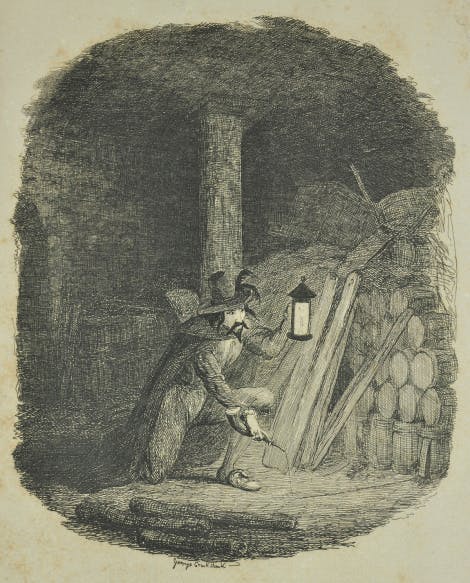
Image: Guy Fawkes leaving a trail of gunpowder by George Cruikshank. © London Metropolitan Archives, City of London (COLLAGE: the London Picture Archive, ref 311903)
How did Guy Fawkes get caught?
The plan very nearly succeeded. It was only thanks to an anonymous letter to the authorities, received in late October, that the King, his family and his Protestant ministers were not all murdered.
An extract reads: ‘they shall receive a terrible blow this parliament and yet they shall not see who hurts them’.
Royal guards searched The House of Lords at midnight and in the early hours of 5 November, Guy Fawkes was discovered in the cellars, with a fuse, a small lamp, a box of matches and 36 poorly-hidden barrels of gunpowder.

Image: Lantern that is said to have been carried by Guy Fawkes © Ashmolean Museum, University of Oxford, AN1887.2
Is this Guy Fawkes’ lantern?
Guy Fawkes is said to have been carrying this iron lantern when he was arrested in the cellars underneath the Houses of Parliament on the night of 4-5 November 1605.
The lantern was given to the University of Oxford by Robert Heywood who had been a Proctor – an official responsible for ensuring the rules of the University are observed.
His brother, Peter Heywood, had accompanied Sir Thomas Knyvett, Keeper of Whitehall Palace, in his fateful search of the cellars and is credited with taking the lantern from Guy Fawkes during the initial struggle and preventing him from detonating the gunpowder.
The lantern seems to have been passed to Robert sometime after an assassination attempt in 1640 left Peter mortally wounded. Robert then passed the lantern to the University of Oxford in 1641.
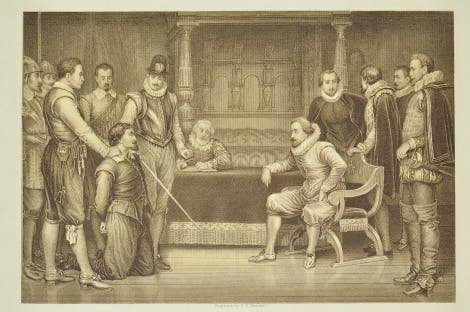
Image: Guy Fawkes interrogated by King James I and VI and his council. © London Metropolitan Archives, City of London (COLLAGE: the London Picture Archive, ref 310647)
The traitor's 'Roman resolution'
Fawkes was arrested and taken to the King. When asked what he was doing in the cellars, Fawkes replied boldly: 'I wish to blow the Scottish King and all of his Scottish Lords back to Scotland.' He also expressed his regret at having failed. Although insulted, James I and VI couldn’t help but praise the traitor’s ‘Roman resolution’.

Image: Sir William Waad, Lieutenant of the Tower of London, © National Portrait Gallery, London.
Guy Fawkes' imprisonment at the Tower
Guy Fawkes was brought to the Tower of London to be imprisoned and interrogated. Sir William Waad, Lieutenant of the Tower, led much of the interrogation in the Great Hall of the King's House, a 16th-century timber-framed building that overlooks Tower Green.
At the time, the monarch or Privy Council had to authorise any form of torture. James I and VI himself wrote the royal warrant: ‘If he will not other ways confesse, the gentler tortures are first to be used upon him, and then step by step you may employ the harsher, and so speede youre goode work.’
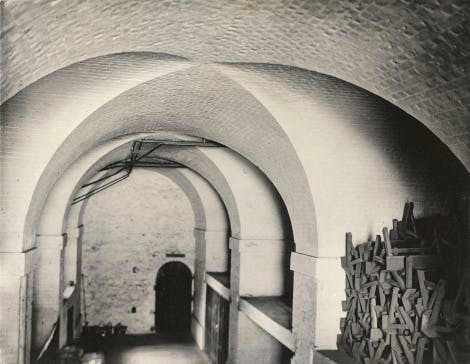
Image: Royal Collection Trust / © Her Majesty Queen Elizabeth II 2018
A dark and fearsome place
The 1500s and 1600s were a period of extreme political and religious upheaval and torture was used in interrogations to elicit information. Even just the threat of torture was sometimes enough to break a prisoner’s resolve.
Many prisoners at the Tower of London were detained and some tortured in the White Tower prison vaults. They must have been a dark and fearsome place indeed; very different from how they look in this photograph from around 1898.
Instruments of torture
When the ‘gentler tortures’ failed, it’s highly likely that Fawkes was racked, probably in the White Tower dungeons.
The rack was a horrible device, designed to inflict excruciating pain as a prisoner’s limbs were pulled in opposing directions until the joints were dislocated or separated.
Did you know?
Fawkes held out bravely for several days, but eventually named his co-conspirators and signed a confession.

A body broken
Guy Fawkes’s signature before and after his interrogation seems to show that he was indeed tortured; his writing hand seems to have been badly damaged.

Image: The White Tower at the Tower of London in the late 1980s / © Historic Royal Palaces
Sentenced to be hanged, drawn and quartered
While Fawkes was at the Tower, the other conspirators fled to the Midlands. They were caught by the High Sheriff of Worcestershire in the morning of 8 November.
Robert Catesby, the Wright brothers, and Thomas Percy were shot dead. The others were taken to the Tower of London.
Fawkes and his surviving co-conspirators, Thomas Wintour, Ambrose Rookwood and Robert Keyes were committed, tried and sentenced to the act of treason.
How did Guy Fawkes die?
On 31 January 1606, Guy Fawkes and his co-conspirators were dragged behind a horse along the streets of London to Westminster Yard. One by one, they were hanged, drawn and quartered.
Fawkes, who was already the most famous of all the plotters, was the last to go up the gallows.
A contemporary account records Fawkes' grisly end: ‘Last of all came the great devil of all, Guy Fawkes, alias Johnson, who should have put fire to the powder. His body being weak with the torture and sickness he was scarce able to go up the ladder, yet with much ado, by the help of the hangman, went high enough to break his neck by the fall.
'He made no speech, but with his crosses and idle ceremonies made his end upon the gallows and the block, to the great joy of all the beholders that the land was ended of so wicked a villainy.’
The body parts of the Gunpowder Plotters were displayed throughout London as a warning to others of the dangers of treason.

Image: Marble monument in the Council Chamber / © Historic Royal Palaces
Memorial at the Tower of London
In 1608, Sir William Waad had a large marble memorial to the Gunpowder Plot erected in an upper room of the King’s House, known as the Council Chamber.
Strange as it may seem, this memorial celebrates his success in foiling a national disaster and to remind other prisoners of the terrible fate that awaited traitors – it must have helped to loosen some tongues!
Out of darkness and into light
The monument records the names of the Gunpowder Plot conspirators, alongside those of the Privy Councillors who conducted their interrogation.
Underneath there is a quote from the Old Testament in Hebrew and repeated in Latin below. It translates as ‘He discovererth deep things out of darkness and bringeth out to light the shadow of death.’ Job XII.22. This may refer to the capture and questioning of the plotters.
Did you know?
This is possibly the earliest permanent commemoration of the Gunpowder Plot that survives today.

Image: James I and VI (1566-1625) c. 1620 by Paul Van Somer. Royal Collection Trust / © Her Majesty Queen Elizabeth II 2018
The bonfire tradition
In January 1606 James I and VI passed a thanksgiving act to celebrate the failure of the Gunpowder Plot and his deliverance from danger.
Called the Observance of 5 November Act 1605, it involved a special church service, bonfires and fireworks.
It remained in force until 1859 although celebrations still take place today.
Another tradition that still lives on is the ceremonial search before the State Opening of Parliament, when the Yeomen of the Guard look for hidden explosives in the cellars of the Palace of Westminster.

Image: Guy Fawkes Mask / Studio Neosiam
Guy Fawkes' Legacy
Although Guy Fawkes was not the mastermind behind the Gunpowder Plot, he certainly became its figurehead. Unfortunately for him, he was the one caught red-handed, the first of the plotters to be arrested and taken to the Tower of London and the last to be executed.
Over 400 years later, Guy Fawkes’ image persists as a symbol of rebellion with protesters across the globe wearing masks of his stylised face.
Today, you can visit the Tower Torture exhibition to uncover the methods of torture used at the Tower of London and see replicas of instruments which inflicted such appalling pain on prisoners like Guy Fawkes.
Browse more history and stories

The Tower of London and the First World War
The Tower of London played an important role in the First World War

The Tower of London and the Second World War
Life at the Tower of London during the Second World War
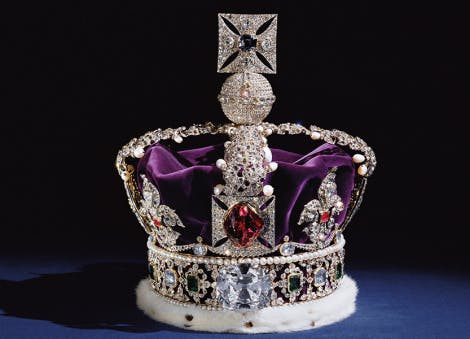
The Crown Jewels
The history of the Crown Jewels, including the Imperial State Crown - a priceless collection used to crown the kings and queens of England.
Explore what's on

- Things to see
Imprisonment at the Tower exhibition
Learn why people ended up as prisoners in the Tower of London, in the very rooms where some of them were held.
- Open
- Tower of London
- Included in palace admission (Members go free)

- For members
- Events
Members-only Ceremony of the Keys
Members-only access to the traditional locking up of the Tower of London, the Ceremony of the Keys.
-
07 December 2025, 18 January, 08 February 2026
- 21:30
- Tower of London
- Separate ticket (advance booking required)

- Things to see
- Tours and talks
Yeoman Warder tours
Tour the Tower of London with a famous Yeoman Warder during your visit. Be entertained by tales of intrigue, imprisonment, execution, torture and much more...
-
Daily
- Tours begin every 45 minutes
- Tower of London
- Included in palace admission (Members go free)
Shop online

Shop Ravens
It is said that if the six ravens were ever to leave the Tower of London then the Tower and the kingdom will fall. Naturally, to preserve the kingdom six ravens are kept to live and protect the Tower of London.
From £2.50

Shop Crown Jewels
For centuries, the Tower of London has safeguarded and showcased the illustrious Crown Jewels, discover our range inspired by these majestic objects.
From £2.50
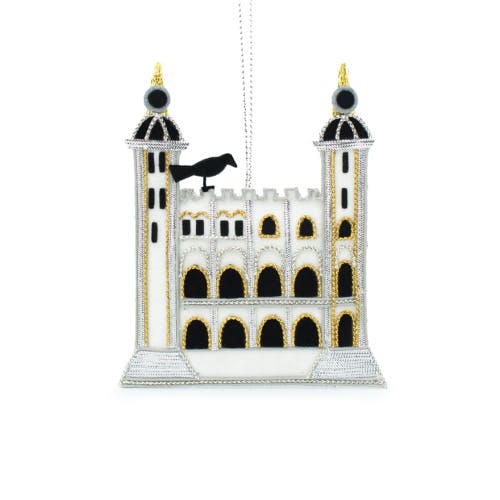
White Tower Decoration
This sparkling silver luxury White Tower hanging decoration is hand embroidered using the same metal thread work techniques used to sew royal dresses and finery in centuries past.
£13.00

